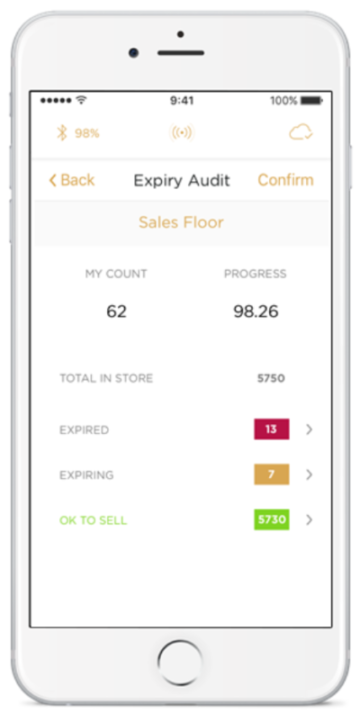Technological advancements mean the Beauty industry is finally ready to utilise individual item tagging
RFID in the Beauty Industry: Brick & Mortar Stores are Ready for a Makeover

Inventory management is a problem as old as retail itself, so when brick and mortar stores look to digitise and modernise themselves for the modern age, shouldn’t their inventory systems do the same? Radio Frequency Identification (RFID) has gradually become embedded in the fashion retail industry due to this need to innovate stock management. What makes the technology unique is that every single RFID tag emits a small radio frequency. An RFID reader picks up hundreds of these signals in a matter of seconds, from several feet away, without requiring a direct line of site. The tag then shares whatever data it is encoded with, typically item info, dates, times and shipping information but theoretically, the only limit to what can be stored and utilised is the imaginations of the designers and engineers.
At its most basic level, RFID allows for incredibly fast and efficient stock management with little room for human error, meaning stock accuracy soars (reaching levels of 99% with RFID) and labour time falls dramatically. The technology also allows for more advanced usage such as faster Point of Sale or the enablement of omnichannel services – something the fashion industry has made good use of in recent years.
So, if the technology is so advantageous, why is it not dominating all retail markets? Initially, RFID labels were not only fairly expensive (averaging out at just under £1 per label) but they were also often too large to tag smaller products. This meant RFID did not make financial or logistical sense for many retailers, particularly in markets with a low individual item value. Another big issue was the interference that metal and liquid products have on RFID signals, meaning certain products could not be tagged with any real confidence.
These roadblocks proved fatal for RFID’s success in many industries, including beauty and cosmetics. But in the Fashion sector, with a high individual article price and the need for high stock accuracy and article availability, it was a huge success. However, these barriers to success in other markets are beginning to disappear, and the business potential of RFID is continuing to grow. The Beauty industry could now look to utilise the tags, achieving similar or perhaps even greater results as those seen in the apparel sector.
What’s changed?
The beauty industry has been keen to implement RFID for some time. Previous efforts to combat its limitations include the use of ‘smart packaging’ that took steps to make tagging cosmetic products possible through packages that are not only big enough to hold the tags in the first place but can also combat the interference caused by metallic or liquid products. This made RFID a possibility in the beauty industry if beauty suppliers were prepared to take the extra steps to make it so. But due to the solution being built into a product’s packaging, it meant it was not appropriate for every product and it was ultimately out of the hands of the retailers themselves, making full shop floor visibility a rarity.
If we were waiting for something of a ‘eureka moment’ for RFID, then the wait may well be over. Just this month, tag producer and RFID-heavyweight Avery Dennison announced the launch of their first on-metal tags. This is a huge breakthrough for the beauty industry and could be the silver bullet for the biggest barrier to entry for RFID. As the solution is very recent, we haven’t seen it applied on a large scale yet. But because the new tags work with liquid products as well as metal ones, beauty products are suddenly RFID-viable.
But this breakthrough is meaningless if labels are still too big to attach to products, or if they are too expensive to really warrant doing so. Thankfully, it’s good news on both fronts. As with any new technology, the price of RFID tags has been gradually dropping since their invention. Whilst previously an individual tag could be priced around £1, these days they are closer to 5p. The size of labels has similarly shrunk, meaning tags can be physically applied to feasibly any product or its outer packaging. This is great news for the beauty industry, as many cosmetic products are smaller and external pull-off labels, like those used in apparel, are not viable. This means the scope retailers have for tagging individual products is far more generous than it was in the past.
Fresh opportunities for beauty retailers
So, we’ve seen evidence that the technology has finally reached a point where it can be used in the beauty industry, but why should we care? What do cosmetic retailers stand to gain from the technology? And, perhaps more importantly, what difference does it make to the customer?
Efficient & accurate stock counts
We’ll start with the most basic principle: RFID revolutionises stock counts. Whilst this may seem like a lesser detail, the accuracy and speed with which inventories are collected does form the backbone of the business case for RFID. With products arriving at stores and distribution centres already tagged, inventory management becomes effortless. Stock counts become a matter of seconds as opposed to minutes (using barcodes) or even hours (using pencil & clipboard). This increased efficiency will have two big impacts on beauty retailers. The first is the reduction in labour intensity of managing stock. Not only do RFID stock counts not eat up the time of the retail staff but having a complete and transparent view of stock also makes item replenishment from the backroom to the sales floor much simpler to manage. Intelligent inventory systems can display alerts when items need replenishment, so staff can spend less time monitoring shop floor levels themselves.
Sales uplift
The other main impact of RFID stock counts is the increase in stock accuracy for retailers. The industry standard stock accuracy without RFID is somewhere around 70% (although retailers often do not realise it is as low as this) compared to 99% with RFID. This stock accuracy coupled with the ease of shop floor replenishment increases article availability and therefore sales by avoiding out of stock situations. Whereas traditionally beauty retailers were often stuck with the choice between neglecting inventory accuracy or losing out on money from higher labour costs or loss of sales, with RFID retailers can have the best of both worlds. This accuracy and efficiency stretch across the entire supply chain, increasing shipping accuracy and aiding logistics at warehouses and distribution centres and, crucially, providing a complete view of stock. Increased process efficiency is perhaps the biggest way RFID adds value to retail. The knock-on effect of this is retail staff having more time to spend on customer service, which improves the shopping experience and increases sales. Beauty retailers could push these results even further by implementing faster point of sale solutions using RFID.
So with accurate stock counts taking place effortlessly both in the store and in distribution centres, and with tags being as cheap as they are, beauty retailers can realistically look at achieving full inventory visibility across the entire supply chain. But what does this achieve? Item level transparency unlocks the real potential of RFID, as it allows innovative solutions and use cases to be deployed which can drastically reduce the time it takes to see a return on investment.
Reduction in shrinkage
For example, one of the biggest challenges for many beauty retailers is item shrinkage. The average shrink percentage in the retail industry is generally about 2% of sales, amounting to $49 billion in losses globally. Having total item visibility would give beauty retailers the tools to combat this critical issue. The complete transparency of supply chains makes individual items entirely traceable, so retailers could pinpoint exactly where shrinkage is taking place and combat it accordingly.

Limited shelf-life is another cause of shrinkage in the industry; one that RFID is well suited to manage as an items sell-by date can be stored on the tag itself. Once scanned, this information then becomes an extension of the 100% article visibility that retailers have access to. This complete view of stock would not only tell staff when items need replenishing from the back room, but it would also tell them which items are passed or approaching their expiry date. Automating the monitoring of this process alongside replenishment would further aid efficiency and assure retailers that products are being marked down and therefore sold instead of expiring, combatting shrinkage and actively increasing sales.
Unlocking effective omnichannel retailing
Having complete item visibility would also mean beauty retailers could finally capitalise on the emergence of omnichannel. The strategy is becoming such a dominant force across retail that it is becoming less and less of a choice to implement and more of a necessity. The beauty industry has yet to make the most of omnichannel as, whilst many retailers operate across multiple channels, they are not fully integrated or connected as well as they could be. A report by Newstore suggests that whilst 80% of shoppers research online before even stepping into a store, only 36% of brands have enabled in-store inventory visibility for customers either online or a mobile app. This experience of seamless integration of shopping experience across all channels is something consumers are beginning to expect, as neighbour industries like fashion already offer such an experience. Perhaps the main reason for beauty being slower to adopt effective omnichannel is the need for total item visibility to really do so. Weaving multiple channels of shopping together requires a total view of stock, which then transforms brick and mortar stores into digital hubs. Now that the beauty industry can finally set its sights on full RFID implementation, it can look forward to benefiting from the omnichannel capabilities that come with it.
The omnichannel experience is a good example of how the beauty industry can use RFID to actively increase consumer engagement, but it is certainly not the only one. Existing technology that is used in other markets like chatbots could easily make an impact in beauty stores, recommending products for customers and informing them on stock. Once RFID begins to become established, we will also no doubt see the emergence of customer engagement solutions specific to the industry and its demands. The technology and its uses are ultimately very flexible so can be manipulated to provide market-specific solutions. But to reach this point the beauty industry will first need to embrace the technology. Then we can really see its full potential unlocked.



